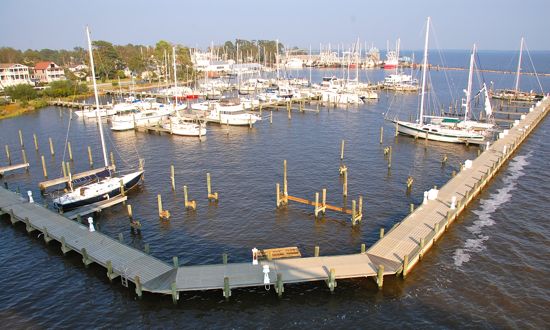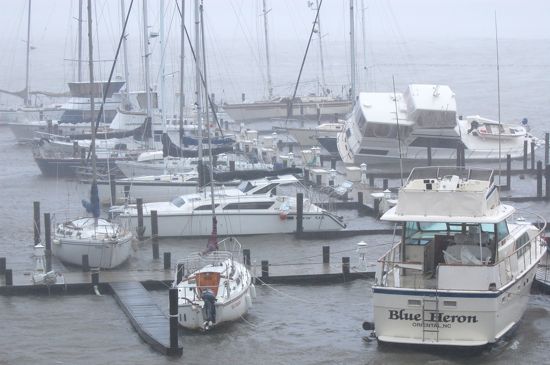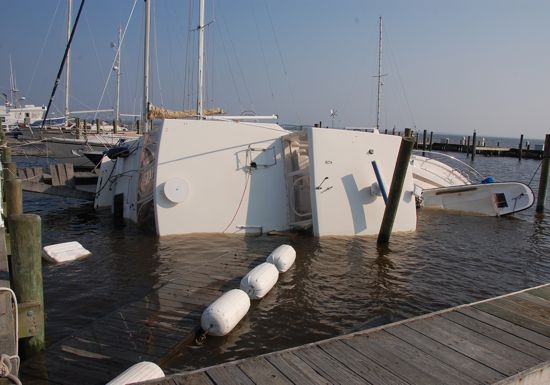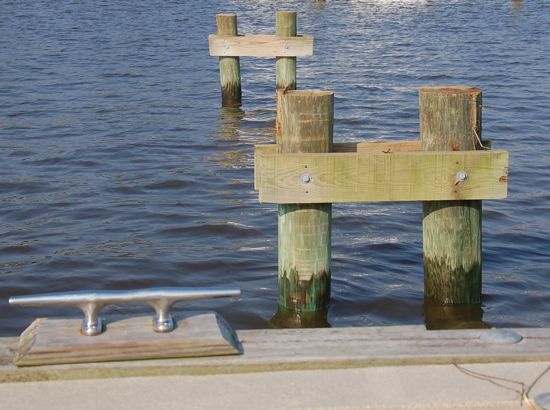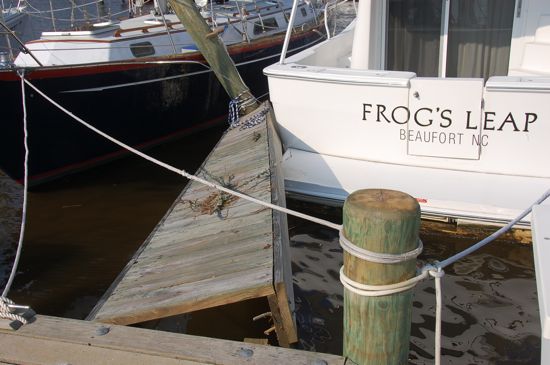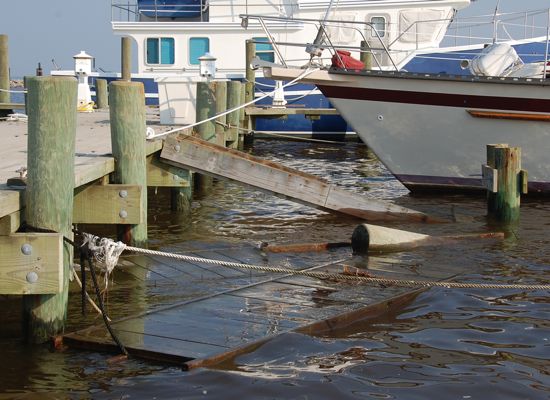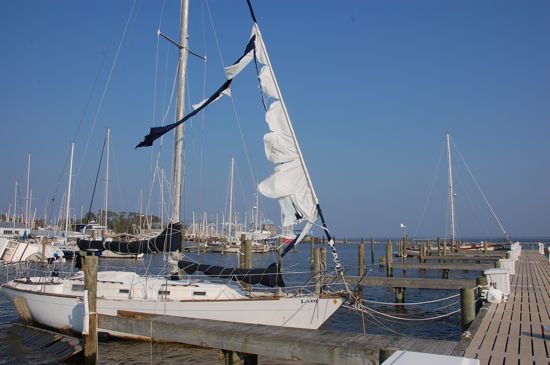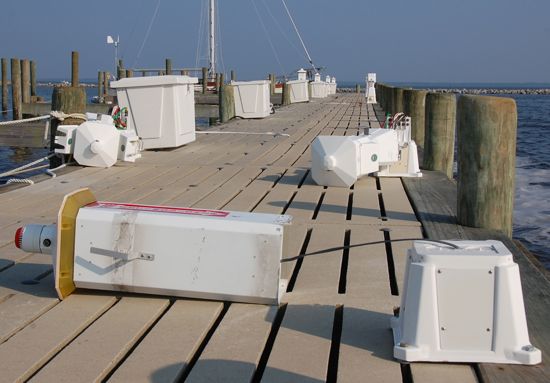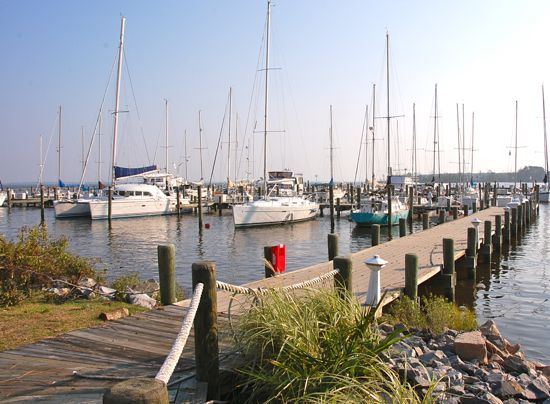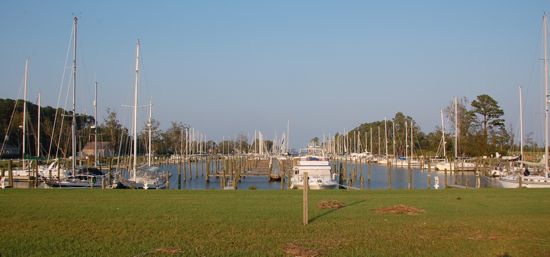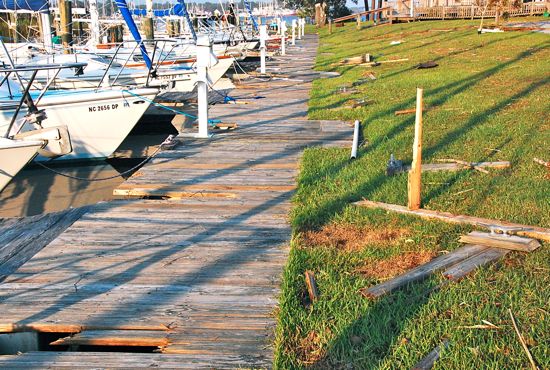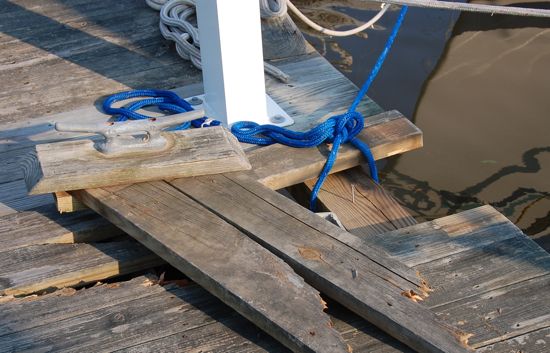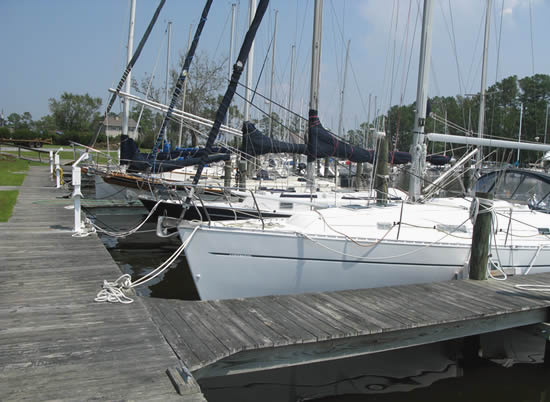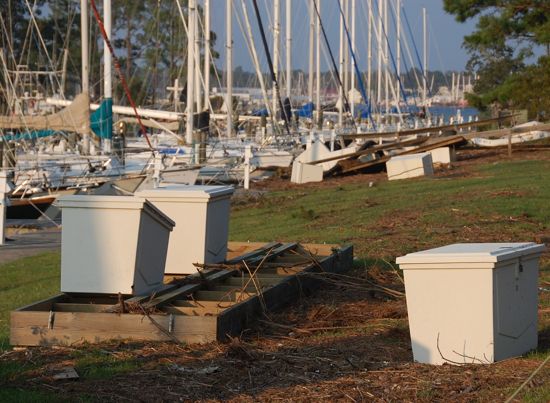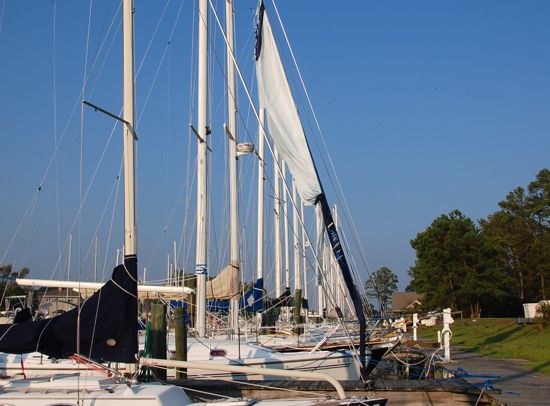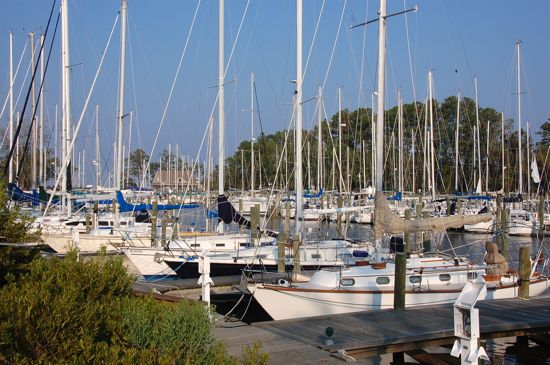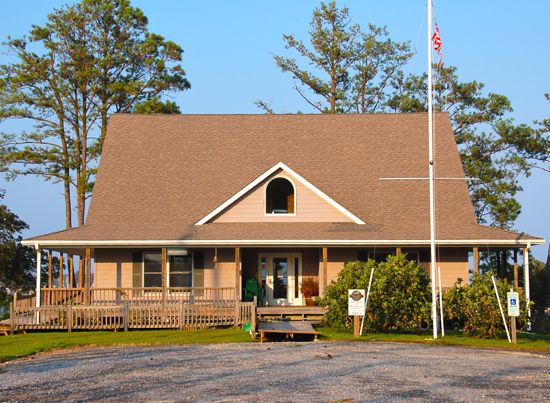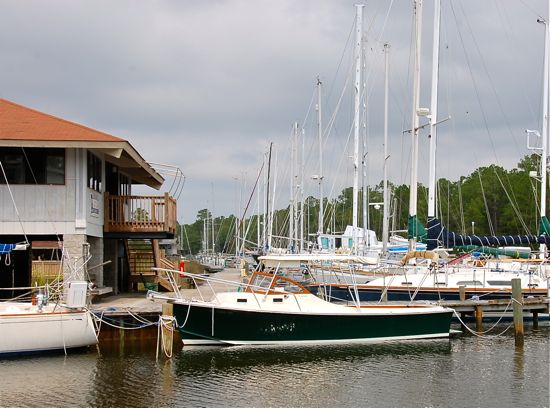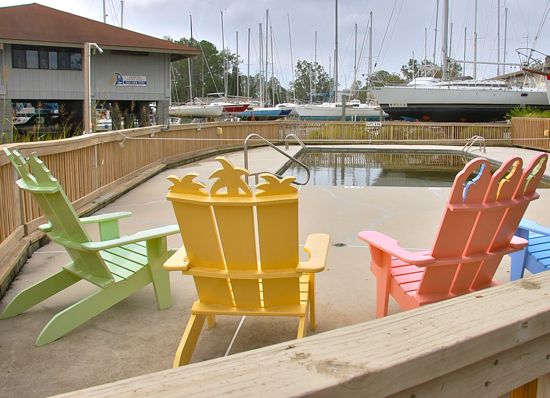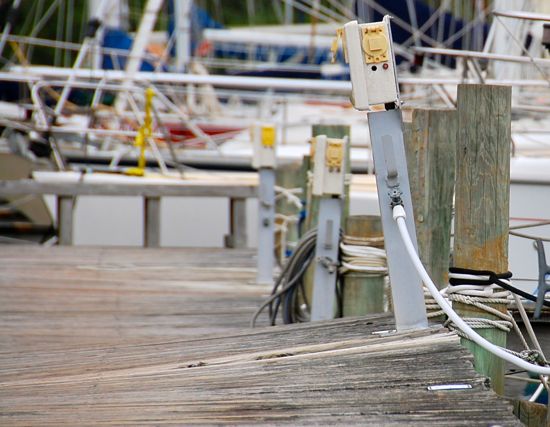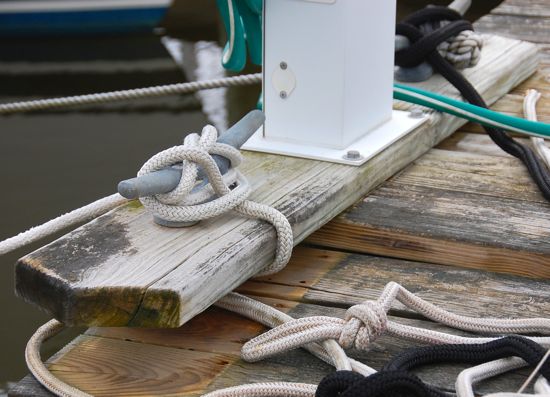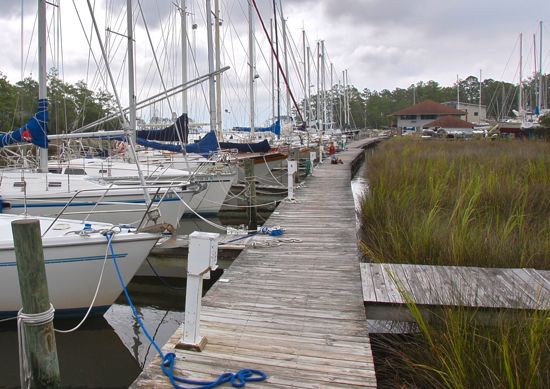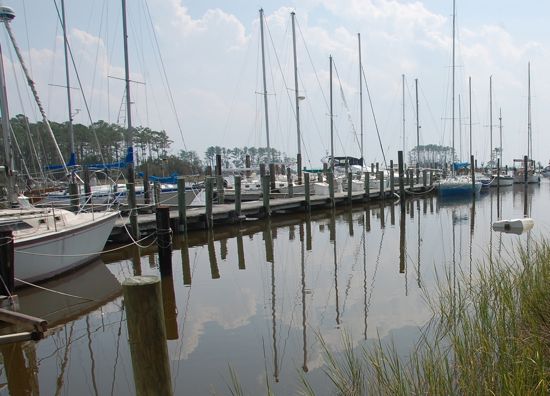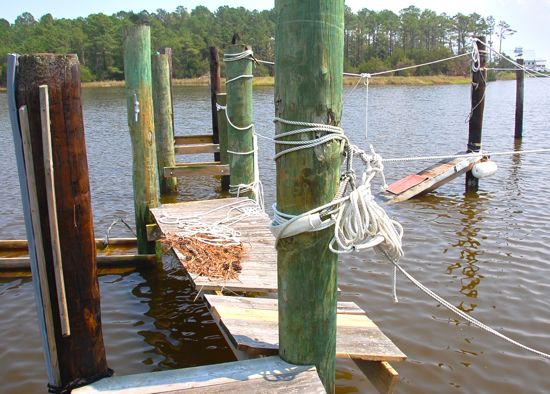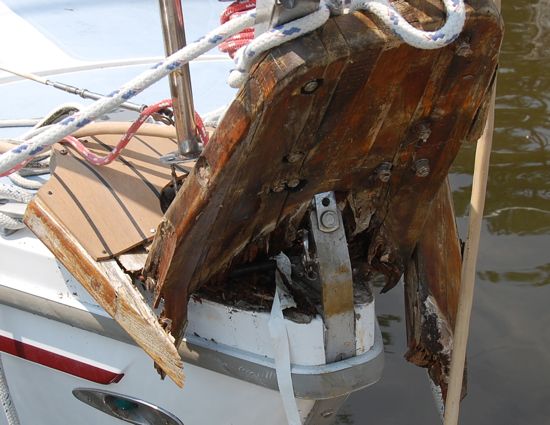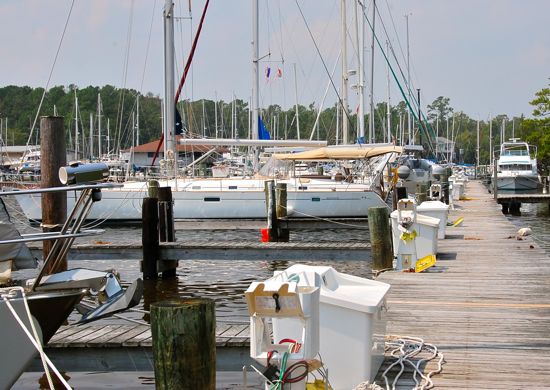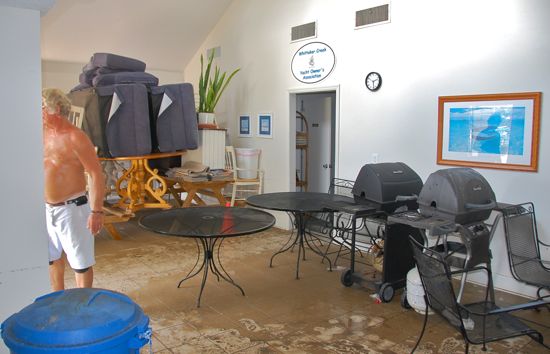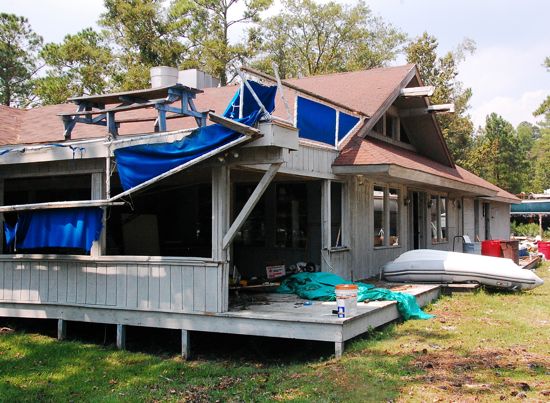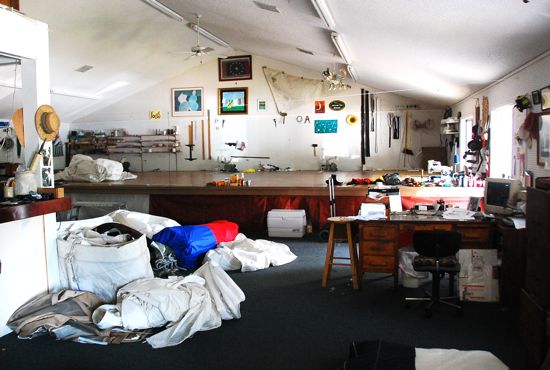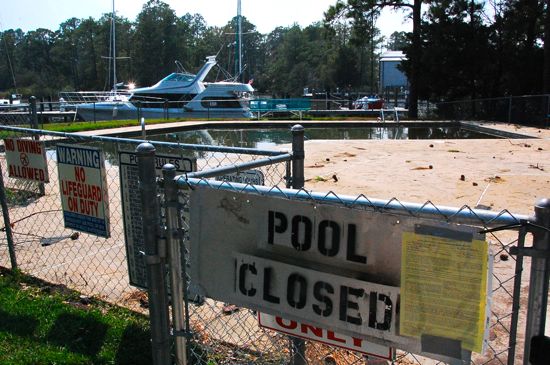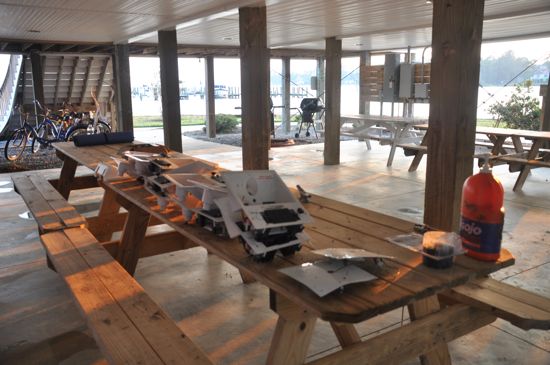It's Sunday January 18, 2026
September 1, 2011
What happened at the marinas in and near Oriental during Hurricane Irene? TownDock.net went out to visit seven area marinas to hear their stories and bring back photos.Irene brought 90+ mph winds and a huge surge to contend with. That surge was measured at 9.5 feet at TownDock.net Oriental location, but that number will vary by location. For example, at Pecan Grove they estimated the surge at 11 feet.
Following is a page on each marina, and how they weathered the storm:
[page]
Oriental’s Marina > Oriental Harbor MarinaOriental Harbor Marina is located in the village on the town-side base of the Highway 55 bridge. Dockmaster Ross Pease reports that before Hurricane Irene’s arrival, some 20 boat owners moved their vessels to other locations. Some anchored across the Neuse in the South River while others relocated to other marinas.The Oriental Harbor Marina as viewed Sunday from the bridge. The largely empty A Dock is visible on the right. Docks B and C are located at photo center. After Hurricane Irene’s eye passed over the marina, the winds shifted to the south – the 3 o’clock position in the photo. This drove the open waters of the Neuse River, amplified by the storm surge, into the marina.View from the bridge- this photo was taken Saturday during Hurricane Irene.Sinking on B Dock. The powerboat “Robin’s Nest” sank in her slip. During the storm surge, she would have been lifted by the rising waters. It appears her propeller or rudder settled on the finger pier to her port side. As the waters receded, the hung appendage tipped the vessel to starboard, leading to submersion.The remains of a finger pier on A Dock. A Dock appears to have suffered the brunt of the damage with many pilings bent and finger piers damaged. Dockmaster Ross Pease says there was only one boat on A Dock during the storm. The surge damaged many finger piers such as this one. Finger piers are the short dock extensions that allow boat owners to access their vessels. Usually decked with heavy timbers and planking, this one was reduced to pilings. The cleat, as with most in the marina, held.The finger pier on B Dock after making contact with “Frog’s Leap”.A downed finger pier on B Dock. The floating wood debris appear to have come from elsewhere..A shredded jib on A Dock. While most damage was water related – the storm surge throwing vessels into pilings and piers – some was wind related. Here, “Lady” is shown with a torn jib (marinas usually recommend sail removal to prepare for a hurricane). During the storm, the high winds unfurled and then ripped the sail.Surprisingly, most Dock boxes on A Dock remain secured. Many power boxes didn’t fare as well..
Pictured is C Dock. While A and B Docks occupy the marina’s deeper waters, C Dock, being closer to shore, is reserved for shallower draft vessels. Buffered from the direct hurricane impact by Docks A and B, this pier suffered minor damage. Damage to vessels was relatively light, with dislodged rub rails and abrasions counting for the majority of incidents.[page]
Oriental’s Marinas > Pecan Grove MarinaPecan Grove Marina is located across from the Oriental anchorage. Sunday, the day after Hurricane Irene, approximately 100 sailboats and power vessels were counted in the slips. The marina occupies formerly agricultural land that was dredged for marina use.Pecan Grove Marina on Sunday. This view is directed toward the marina’s north-east facing entry to the Neuse River. The marina’s narrow opening would have been exposed to the storm winds preceding Hurricane Irene’s eye. Once the eye passed, winds would have blown from the photo’s 3 o’clock position.Cleats ripped from the docks. The majority of loose cleats were located in the section of the marina that leads to the Neuse River. The storm surge would have flowed through the narrow opening, leading to great stress on the dock.Failed cleats were attached to boards secured to the pier’s substructure. When the boards failed, the cleats broke free. During the storm, lines securing vessels to the dock were then tied directly to the pier.View of the docks on the side nearest the highway. In many places there was no obvious storm damage.Dock boxes are stored on dedicated platforms at Pecan Grove. They were placed away (and higher) from the docks after Isabel. But not high enough for Irene. Here, 2 boxes are all that remain where many more had been stored.Torn furling jib. As of Sunday, 2 torn furling jibs were evident. Normally furled tightly when not in use, this jib failed during Hurricane Irene. To minimize the risk of damage, some sailboat owners took the precaution of removing their boat’s jib. In the aftermath of Hurricane Irene, the marina is discussing requiring sail removal as part of hurricane preparation.The view looking toward the marina’s river opening, located at approximately the 9 o’clock position. Damage on this side of the marina included scraped rub rails and a swimming pool filled with storm water. The clubhouse, seen in the distance, escaped major structural damage.The Pecan Grove clubhouse had its deck and rails twisted, but it did not suffer any major damage. The clubhouse did not flood.Pecan Grove Owners Association President and Developer Lee Cox said Irene’s waters were at least a foot higher than Isabel’s (2003) at Pecan Grove. Cox was proud that no boats sank, and stated “the only damage on boats you’ll find are some worn rub rails.”
[page]
Oriental’s Marinas > River DunesAt River Dunes, JC Cappelmann, Director of Operations, says the 94 boats that were at the floating docks got through Hurricane Irene without damage.Irene had been a test, of sorts. Grace Harbor didn’t exist when Hurricane Isabel visited Pamlico County in 2003. So, Hurricane Irene was the first real trial for the marina at River Dunes. Cappelmann says that, “the marina did what it was supposed to do.”
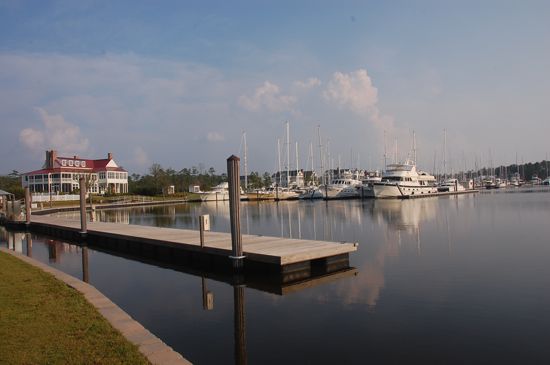 River Dunes Grace Harbor Marina.
River Dunes Grace Harbor Marina.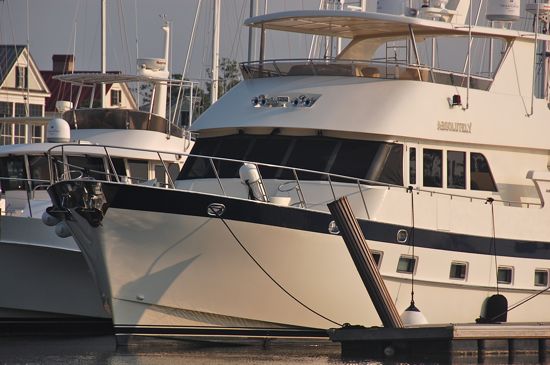 “Absolutely” is an 80-foot boat at RIver Dunes. This piling, closest to the entrance of River Dunes Grace Harbor, was damaged in the storm.
“Absolutely” is an 80-foot boat at RIver Dunes. This piling, closest to the entrance of River Dunes Grace Harbor, was damaged in the storm.“I lost two pilings,” he says, noting that one was attached to an 80-foot boat straining in the 90-95mph winds. The pilings, on which the docks rise and fall, are 11 feet tall.
JC says he and his wife watched the storm from one of the homes on the harbor at River Dunes. The water came up slowly, he says, til it reached a level four feet below the cap of the pilings. Then, in just twenty minutes, he says, the water rushed in. It rose 2 more feet. The water level stayed two feet below the tops of the 11-foot tall pilings. In that, he says, the system worked.
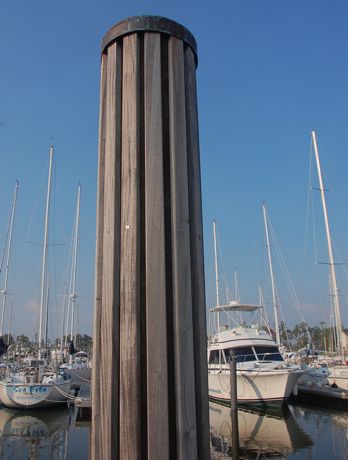 11 foot piling at River Dunes marina.
11 foot piling at River Dunes marina.What if, we asked, a future hurricane brings a surge that is higher than the pilings that keep the floating docks in place? “If we go a couple of feet higher,” Cappelmann says, “we’d have a bigger problem and way bigger fish to fry in the county.”
 JC Cappelmann, Director of Operations at River Dunes Harbor Club and Grace Harbor Marina.
JC Cappelmann, Director of Operations at River Dunes Harbor Club and Grace Harbor Marina.The River Dunes marina, Grace Harbor, is about half a decade old. It was man-made, scooped out of an area that charts called Gum Thicket and it has a canal that leads from the marina to Broad Creek. That one opening is to the northwest. River Dunes folks say that was by design as that wind direction is less problematic in hurricanes. Fetch is reduced as a result.
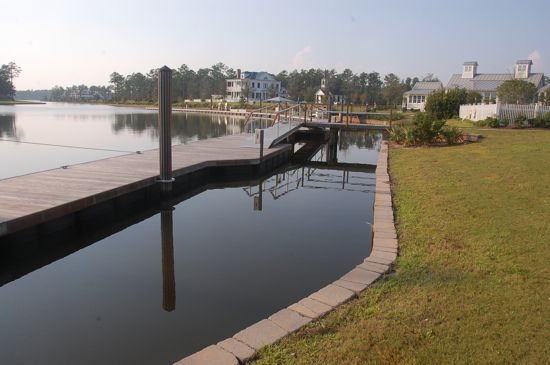 River Dunes Grace Harbor, in background is the canal leading to Broad Creek (and from there, the Pamlico Sound). It is positioned to the northwest. In foreground is the top of the bulkhead, which was engineered to let water seep in and out, and reduce the dramatic suction action when waters receded.
River Dunes Grace Harbor, in background is the canal leading to Broad Creek (and from there, the Pamlico Sound). It is positioned to the northwest. In foreground is the top of the bulkhead, which was engineered to let water seep in and out, and reduce the dramatic suction action when waters receded.Around the edge of the harbor, the bulkheads are stacked stone, interwoven with kevlar. And for a dozen feet behind the bulkhead, and under the grass lawn, there is stone, all of which creates what JC Cappelmann says calls a big French drain. This system allows water a place to freely come and go, so that when the water drains, as it eventually does in a hurricane, it doesn’t exert the hydraulic pressure that often brings down other bulkhead walls.
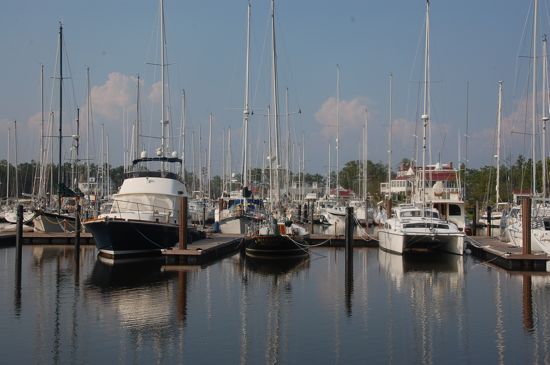 C Dock at River Dunes, closest to the entrance, just opened last week.
C Dock at River Dunes, closest to the entrance, just opened last week.The marina had just opened slips at a new dock just last week. They needed them. JC says that he has about 40 boats in the slips all the time. 50 of them were here just for the hurricane. Ed Mitchell, the developer at River Dunes, says he had to turn boaters away.
As for Irene, JC says it “was a strong storm and a big storm.” The eye of it lasted so long, he says, he spent the time on a forklift, clearing debris from the area around the marina, until the backside of the hurricane kicked in.
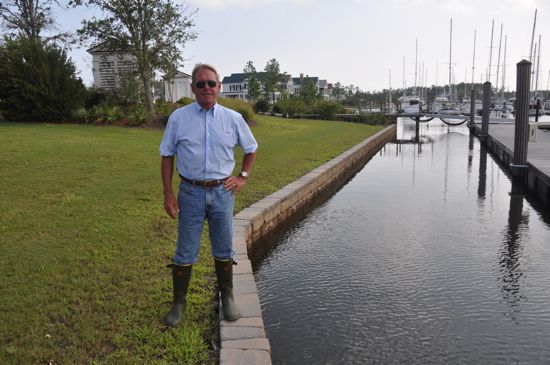 JC Cappelmann on the bulkhead at River Dunes Grace Harbor.
JC Cappelmann on the bulkhead at River Dunes Grace Harbor.While it was the first hurricane for Grace Harbor, it was not JC Cappelmann’s first. He spent another career as a yacht master in the Caribbean and encountered a few hurricanes along the way. Most of those, though, were spent on the water and not on land. At sea, he says, you can at least ride out the storm.
[page]
Oriental’s Marinas > Sailcraft Marina
Sailcraft Marina is located on the west shore of Whitaker Creek, adjoining Sailcraft Services boat yard (Sailcraft Marina is owned and operated by Henry Frazer, Sailcraft Services is owned and operated by Alan Arnfast). Most of the marina’s 30 slips were occupied during hurricane Irene. As the storm swept the facility, active measures were taken to keep vessels safe – adjusting dock lines, retying vessels, adding protective fenders.Vessels escaped Irene without major loss. Damage to the marina pier included loose boards, various bent piles and a section of dock raised and twisted by the storm surge.
Ronnie Kennamer, assisting the with marina with post-hurricane repairs, reports that as of Tuesday, the marina bathrooms and showers were functional. Electricity and water were also being restored to slips. During the storm, water entered the power boxes that provide boat slips with electricity. Efforts Tuesday were underway to rinse and dry the boxes with limited power already restored to slips.
The Sailcraft Marina docks looking north past the main office that houses slip owner facilities. The structure is built on cement block piles and escaped immersion.No swimming – but sitting’s okay. Hurricane Irene deposited a mixture of water, mud and debris into the marina’s pool. It will remain closed until water quality inspections can be met. Chairs are still available for poolside loungingThe storm surge was so powerful, it raised this main section of marina dock. The marina believes the pilings can be pounded back into position, re-leveling the pier’s deck. The power pedestals – like the bent one shown – are being dried out. They were submerged by Irene.A cleat and pedestal base pulled loose by the storm.The view along the docks leading to the main office – the structure with the redish-brown roof. The smaller structure in the foreground is the pool house. It was from the direction of the main office – the mouth of Whitaker Creek – that waters rushed into the marina.[page]
Oriental’s Marinas > Sea Harbour Yacht Club
Late Sunday afternoon, Sea Harbour Yacht Club assistant dockmaster Lisa Thompson was almost jubilant about how well the boats there had fared in Irene. She’d spent a long day working along the docks, assessing things and had the stats at the ready, like a baseball box score. No boats lost, a few scratches, two bent stanchions, one rub rail pulled.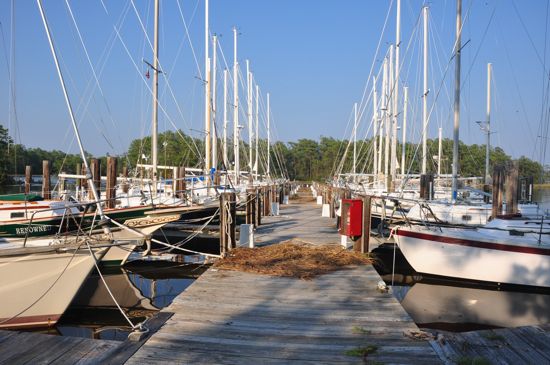 The main dock at Sea Harbour Yacht Club. Add about ten feet of water and no sign of most pilings and you’d have the scene that was there during Hurricane Irene’s storm surge on Saturday. The marina and its boats survived well.
The main dock at Sea Harbour Yacht Club. Add about ten feet of water and no sign of most pilings and you’d have the scene that was there during Hurricane Irene’s storm surge on Saturday. The marina and its boats survived well.The marina on Pierce Creek is in many places naturally protected, but Thompson says the northeast winds that pushed in the storm surge on Saturday came straight toward Sea Harbour’s main dock. The part of the dock that bore the first brunt of the surge lost one roughly 6 foot section. (Thompson noted that it had been nailed down rather than screwed on and so was more likely to come up.)
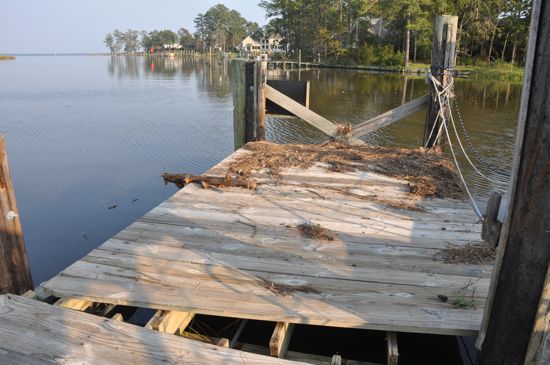 A section of the outermost dock at Sea Harbour Yacht Club came loose. Lisa Thompson noted that it had not been screwed in as the other portions were. The replacement will be.
A section of the outermost dock at Sea Harbour Yacht Club came loose. Lisa Thompson noted that it had not been screwed in as the other portions were. The replacement will be.Other than that, a loose board or two, or a curve in the dock, everything stayed intact. One rogue piling washed in from who-knows-where. All of Sea Harbour’s stayed where they’d been put.
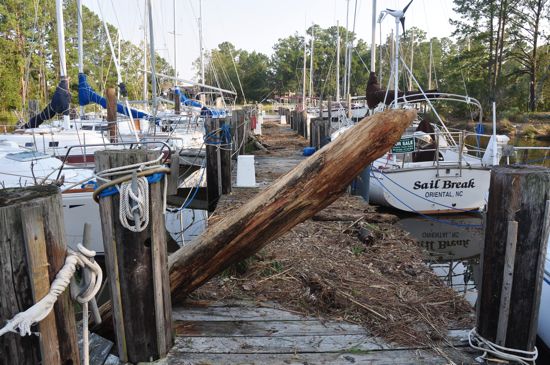 No pilings came loose at Sea Harbour, says Lisa Thompson, but one rogue one drifted in and came to rest, after the surge, on one of the docks. Pine needles, swept from nearby — and far off — forests, were a common sight on the docks throughout the marina.
No pilings came loose at Sea Harbour, says Lisa Thompson, but one rogue one drifted in and came to rest, after the surge, on one of the docks. Pine needles, swept from nearby — and far off — forests, were a common sight on the docks throughout the marina.Thompson says she spent the hurricane in the safety of some friends’ home just across the creek and watched as the waters rose.. and rose … and rose. When she glanced at the marina’s back creek during the height of Irene’s surge, it took a moment to adjust her eyes. She saw nothing — nothing — at first and then looked up to where the boats were riding easily 10 feet higher than usual.
But the oddest scene, she says, played out at Sea Harbour’s main dock. Thompson on Sunday pointed to midway down the dock and one piling about a half a foot higher than the others around it. It’s 11 feet over the normal water level, she says, and that last half foot of it was the only bit of piling visible in the entire area at Irene’s peak surge. The rest of the scene was filled with the boats, in two orderly rows at their slips, fastened to their now invisible pilings…
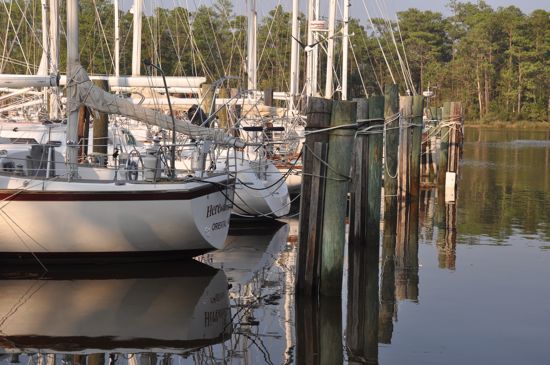 Midway down this line of pilings at Sea Harbour is one that is about a half foot taller than the rest. It’s at 11 feet above normal water levels. It’s top 6 inches was the sole evidence of piling showing during Irene’s storm surge, says LIsa Thompson.
Midway down this line of pilings at Sea Harbour is one that is about a half foot taller than the rest. It’s at 11 feet above normal water levels. It’s top 6 inches was the sole evidence of piling showing during Irene’s storm surge, says LIsa Thompson.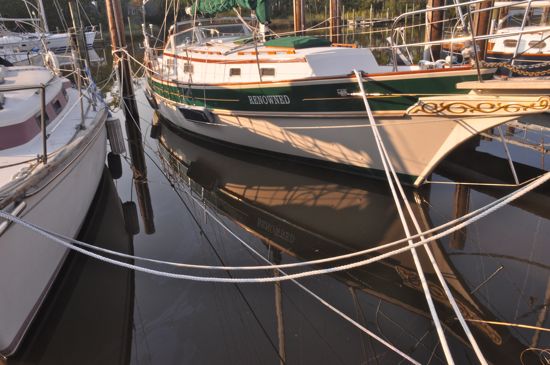 Double dock lines at Sea Harbour. Part of the plan for surviving a hurricane and its storm surge.
Double dock lines at Sea Harbour. Part of the plan for surviving a hurricane and its storm surge.With such enormous forces of nature at play, how did the boats survive as well as they did? Asked if there was a secret, Lisa Thompson paused and then said, “I’m the ‘Hurricane Bitch.’”. A veteran of 8 hurricanes before Irene, she says she enforced a policy that all boats have double dock lines at each quarter and that spring lines be attached as well. She says she didn’t abide complaints — and she says there were some — about having to buy extra line. (It is for this reputation that we didn’t insist when she declined to have her photo taken…)
Thompson says she also insisted that she wanted boat owners to strip their boats of anything that could catch the wind. “I don’t want anything loose, “ she says. A look around on Sunday indicates that the policy worked.
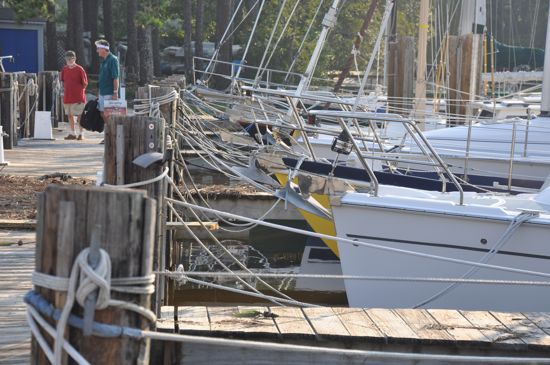 Up and down the docks at Sea Harbour, double dock lines. Some boat owners survey the scene the day after Irene. The marina is discouraging visitors, even boat owners, because the ongoing electric outage means the sewage system can’t handle too much use.
Up and down the docks at Sea Harbour, double dock lines. Some boat owners survey the scene the day after Irene. The marina is discouraging visitors, even boat owners, because the ongoing electric outage means the sewage system can’t handle too much use.Thompson says that during the hurricane on Saturday, she saw a boat at a private dock across from the marina held on with minimal lines until its owner swam out to it in the rising waters, climbed aboard, found some dock lines and secured the boat more firmly. If he hadn’t she says, the boat could’ve lurched free and done a lot of damage to the Sea Harbour vessels in their slips.
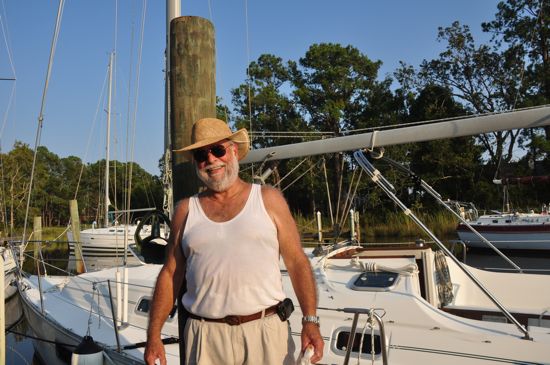 Roger Quillin of Raleigh came to check on his Beneteau, Morning Mist the day after. He’s kept his boat there for years and says, “so far, we’ve been lucky.” He was a bit apprehensive this time because for the first time in a long time, a boat was tied up at a private dock a short distance across from the creek from marina, rather close for comfort in a hurricane. (Lisa Thompson told him that at one point in the hurricane, that boat’s owner swam out to it and found more lines on the boat, and secured it. Had it gotten loose, other boats, including Roger’s could have been threatened.)
Roger Quillin of Raleigh came to check on his Beneteau, Morning Mist the day after. He’s kept his boat there for years and says, “so far, we’ve been lucky.” He was a bit apprehensive this time because for the first time in a long time, a boat was tied up at a private dock a short distance across from the creek from marina, rather close for comfort in a hurricane. (Lisa Thompson told him that at one point in the hurricane, that boat’s owner swam out to it and found more lines on the boat, and secured it. Had it gotten loose, other boats, including Roger’s could have been threatened.)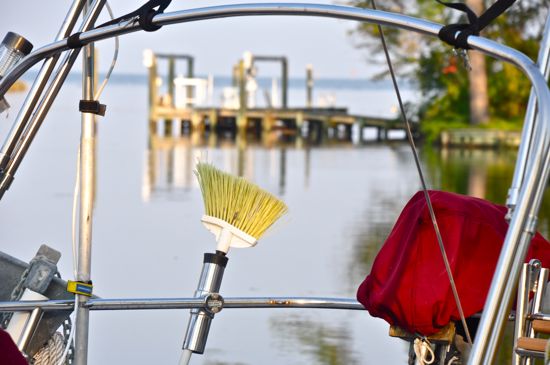 A bigger broom may be needed, but overall, says Lisa Thompson, Sea Harbour fared well in Irene.
A bigger broom may be needed, but overall, says Lisa Thompson, Sea Harbour fared well in Irene.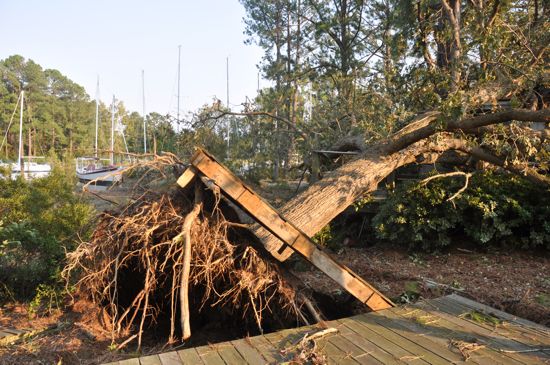 At Sea Harbour Yacht Club, a tall oak fell.
At Sea Harbour Yacht Club, a tall oak fell.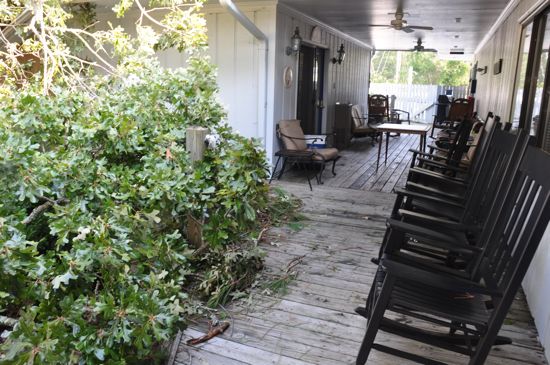 On the porch at Sea Harbour. At the height of Irene’s storm surge, the water reached to the edge of that porch. At left is the upper reaches of the oak tree that fell in front of and to an extent, on, the clubhouse.
On the porch at Sea Harbour. At the height of Irene’s storm surge, the water reached to the edge of that porch. At left is the upper reaches of the oak tree that fell in front of and to an extent, on, the clubhouse.[page]
Oriental’s Marinas > Whittaker Creek MarinaWhitaker Creek Marina Dockmaster Dan Steiger reports the facility weathered hurricane Irene well, escaping major damage to vessels and piers. Harder impacted was the marina’s club house. It flooded and will need extensive clean up and repair. Steiger says the club swimming pool filled with storm water and will likely remain closed for the remainder of the summer.Whitaker Creek Marina as it appeared Monday. The marina occupies two docks on the creek of the same name. West Dock contains 23 slips. East Dock contains 59 slips. Pictured is one half of East Dock. A semi-submerged dinghy is visible off the shoreline.Damage to Whitaker Creek’s East Dock. This finger pier was directly exposed to hurricane Irene’s force. It failed but the remaining finger piers remained largely intact. Other dock damage included missing boards and a few displaced or missing storage boxes.Dan reports that, overall, vessel damage was minimal, largely confined to abrasions and some dislodged fittings. While some boat owners moved their craft, he reports “not too many left.” This East Dock vessel suffered more damage than neighboring vessels.The East Dock appeared largely unaffected by Hurricane Irene. While the shore power electrical boxes suffered immersion, Steiger believes they are salvageable.“Tara” dismasted. Between Whitaker Creek Marina’s East and West docks lies a fuel dock owned by Knute Bysheim. Larrry Summers’ ketch lost both her masts while tied here. The dock, and vessels berthed there (with the exception of Tara), escaped major structural failure.Whitaker Creek Marina is owned by the Whitaker Creek Yacht Owner’s Association. This is how the club house appeared Monday afternoon. Dan Steiger, pictured, reports the structure flooded heavily. He says the first 4 feet of sheet rock, because it absorbed moisture, will need replacing. Citing additional repairs, he feels the club house will not be fully functional “for at least a couple of weeks.” Restrooms and showers should be available as soon as power and electricity have been restored.The structure that houses the Whitaker Creek Marina club house has two occupants. The section pictured, owned by Knute Bysheim, suffered storm damage including flooding and a dislocated porch. The bench pictured on the roof was not deposited by Hurricane Irene. It remains from an earlier business.Located just off the marina docks is Wally Chapin’s Oriental Sailmakers. Wally says the floor of his sail loft was covered in 6 inches of water but damage was minor. Early Monday afternoon, before his power had been restored, he said, “all I need is electricity to get back to work.”Prior to Hurricane Irene, the marina’s swimming pool had been in use. Replacing the murky water with clean could take a while. Dan says the pool may remain closed for the rest of the year. Despite holding onto some of the storm’s muddy remains, the pool appears structurally intact.[page]
Oriental’s Marinas > Whittaker Pointe MarinaWhittaker Pointe Marina is at the end of the Whittaker Creek channel coming in from the Neuse River. With some 50 slips, it offers both slip rental and sales, plus transient dockage. Most boats left for the storm – there were 5 in slips for Irene.
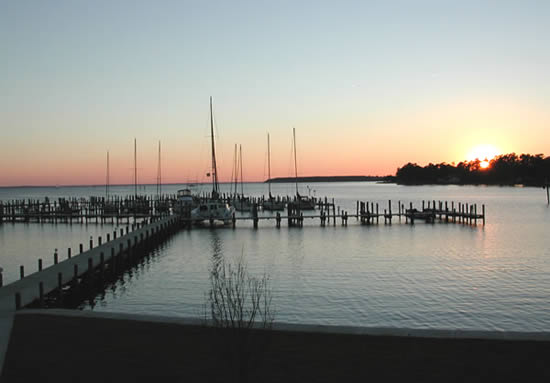 The view from the club house.
The view from the club house.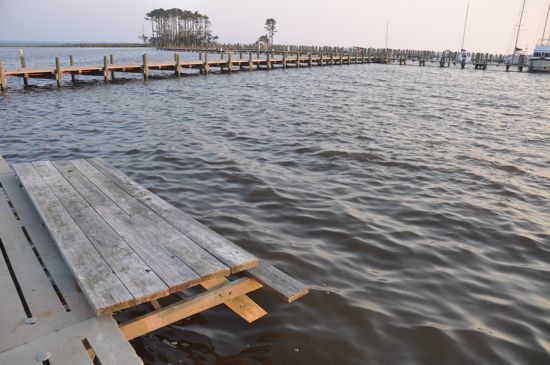 The force of the wind and water jammed a picnic table in to the bulkhead where it remained on Sunday.
The force of the wind and water jammed a picnic table in to the bulkhead where it remained on Sunday.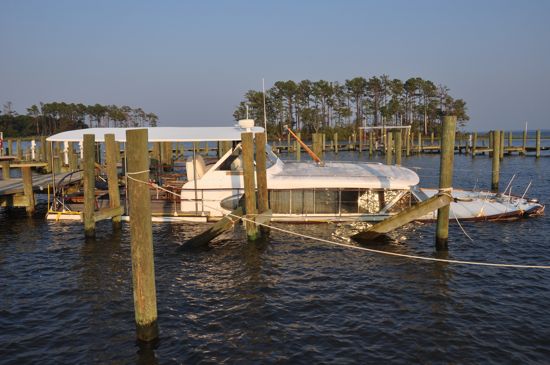 The wooden Chris Craft, “Journey” sank in Irene. Dockmaster Ashley Irwin says its docklines broke.
The wooden Chris Craft, “Journey” sank in Irene. Dockmaster Ashley Irwin says its docklines broke.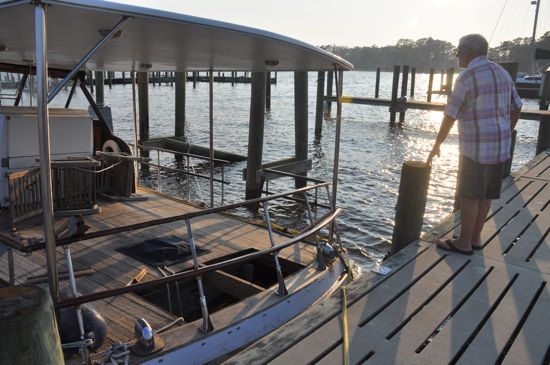 Nearby resident Manfred Rott took a walk out on the docks Sunday night and paused to consider what happened to the motor vessel, “Journey”.
Nearby resident Manfred Rott took a walk out on the docks Sunday night and paused to consider what happened to the motor vessel, “Journey”.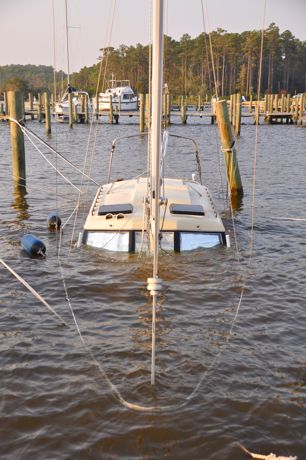 An unsettling outline, the sailboat’s submerged pulpit and lifelines offering up the only semblence of sailboat shape. The boat is a 36’ Pearson pilothouse. Dockmaster Ashley Irwin says it sank due to a broken plastic thru hull coming from the cockpit drain.
An unsettling outline, the sailboat’s submerged pulpit and lifelines offering up the only semblence of sailboat shape. The boat is a 36’ Pearson pilothouse. Dockmaster Ashley Irwin says it sank due to a broken plastic thru hull coming from the cockpit drain.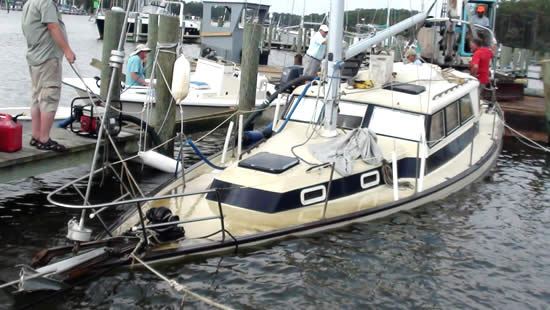 Tuesday the boat was raised. Dockmaster Ashely Irwin explained “It was Henry’s idea on how to get the boat up.” Bobby Prescott was called in and they “raised the stern” so the water could run forward.
Tuesday the boat was raised. Dockmaster Ashely Irwin explained “It was Henry’s idea on how to get the boat up.” Bobby Prescott was called in and they “raised the stern” so the water could run forward.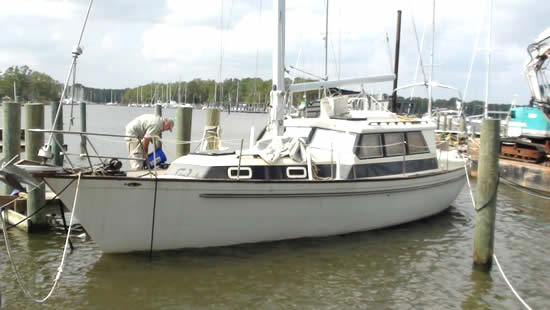 Back afloat, and bound to Sailcraft for repairs
Back afloat, and bound to Sailcraft for repairs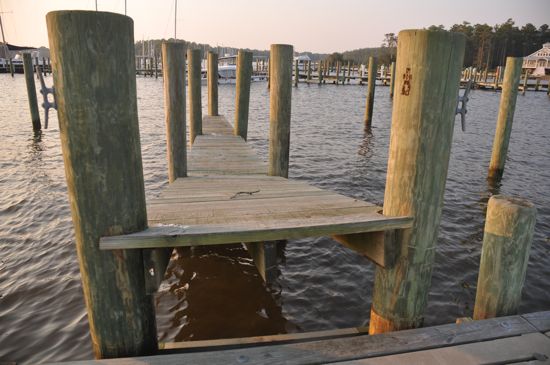 A finger pier that lifted. Others, along the dock facing out to the river, were not in place Sunday.
A finger pier that lifted. Others, along the dock facing out to the river, were not in place Sunday.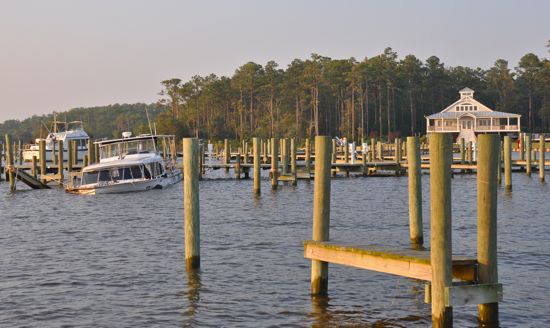 The view from the docks looking back at the Whittaker Pointe Marina clubhouse.The clubhouse at Whittaker Pointe got through Irene with no flooding or damage. The space underneath provided a place to get down the business of cleaning up after Irene. Here, some of the components of the electrical boxes from the docks.
The view from the docks looking back at the Whittaker Pointe Marina clubhouse.The clubhouse at Whittaker Pointe got through Irene with no flooding or damage. The space underneath provided a place to get down the business of cleaning up after Irene. Here, some of the components of the electrical boxes from the docks.While there were some pilings and finger piers damaged, the concrete “hog slat” construction of the docks withstood the hurricane.
